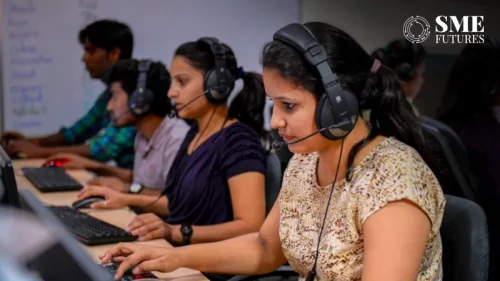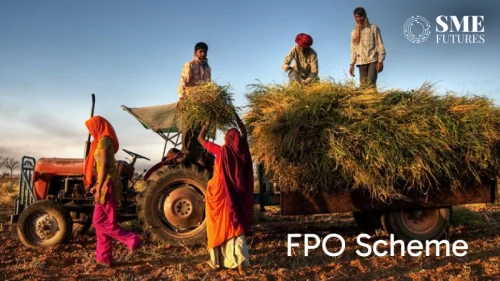If ever there were a golden era for the sportswear manufacturing in India, it is now. The awareness about sports has increased overall; even those who are not active sportspersons are biting into the fitness pie. Not to be left behind, even Prime Minister Narendra Modi called out to the youth to be a part of the fitness movement. This is a sign of the times we live in.
International brands have had a dominating presence in the sportswear market in India. However, local challenges have also sustained themselves in different market segments. According to a report on sportswear in India for 2016-17 by Wazir Advisors, the share of local vendors is 40 per cent, while that of international brands is 60 per cent. The Big 4 international brands – Adidas, Reebok, Nike and Puma – collectively account for Rs 2,800 crore of the market, while the total worth of other global brands is around Rs 800 crore. The organised Indian brands account for Rs 700 crore, while the remaining Rs 1,700-crore share goes to the regional players. While their revenue figures may not be as impressive as those of the international brands, local players have one thing going for them – their costing.
Indian sportswear brand Spunk, homegrown label of Future Lifestyle Fashions, is one such example. “Spunk is for the Indian market, since it is cotton-based. Despite costing one-third of the price of Reebok, its quality is as good as theirs. It is primarily sold in Tier II and III cities and available at Big Bazaar and FBB brick-and-mortar outlets. There is a team of 10 to 11 designers who are busy working around the body type, colour fasting, international trends and quality sportswear,” says Anurag Bahri, chief of design at the company.
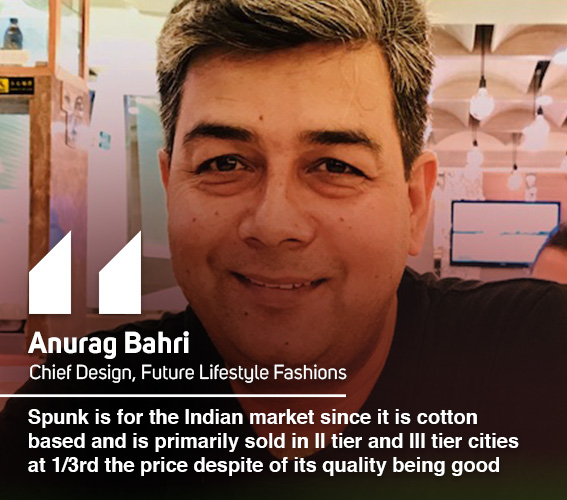
He adds that their target audience is the youth with their athleisure clothing that includes extremely light weight bio-polish supersoft T-shirt and tech jogger pants. “This is achieved with a combination of polyester and cotton that is moisture-absorbent in nature,” he explains.
Also read: SMEs need to adopt predictive analytics to manage their human resource effectively: CEO, SHRM
The company also manufactures products for international brands like Umbro (British sportswear and football equipment supplier) and Champion (American sportswear manufacturer). “For Umbro, we make cotton tees in India, while for Champion we use moisture management under our double dry technology, which is chemical wicking mostly done in China,” he explains.
Shiv Naresh Sports provides active and passive wear to all the Olympic sports/games and many sport federations and leagues. It claims that the Indian contingent at the latest Commonwealth Games largely wore its clothing and shoes. Most of the country’s major federations and leagues too wear its gear. Each game’s uniform is made as per the event’s specifications, styles and fabric.
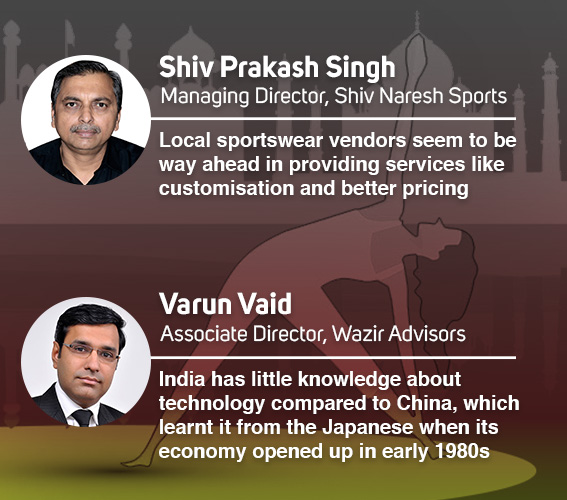
“The local vendors seem to be much ahead in services like customisation and pricing,” says Shiv Prakash Singh, managing director of the company. It specialises in uniforms for events and practice along with sports kits. Started in 1987, this Delhi-based company is now selling pan-India, but rural areas form the major chunk of the clientele as the durability of its gear gives the lesser spenders worth for their money. Active sportswear comprises 40 per cent of its business, while the rest is of passive wear.
Fila India caters to Tier II and Tier III cities with its middle line street sportswear, which includes skating, skiing, basketball, tennis and two-wheeler motorsport range. The brand was relaunched in India last year. Its creative director Abdon Zerom Lepcha says that the company’s heritage collection of luxurious athleisure is made in India and China, while the footwear is completely manufactured in China. “We do not delve into high-tech performance wear. The motorsport range decision was taken after seeing the upward trend in sales of the two-wheeler bikes in February 2018 in the country. We shall wait to review our growth fairly after four seasons, as our event marketing is yet to begin properly,” he adds.
Experts see the sports market for local brands expanding at a constant pace and find the growth logical. “An emphasis on fitness and hygiene with a rise in local brand consciousness as well as an increase in women in the workforce should boost the demand for appropriate products in the market,” says Varun Vaid of Wazir Advisors Pvt. Ltd.
Besides these brands and the Big 4, there are other known names like Asics, Columbia, HRX by Hrithik Roshan, Yepme, Prettysecrets, Lotto, Campus Sutra, 2Go Active Gear USA, Proline, Under Armour, Ajile by Pantaloons, Kappa, Dida SportsWear and Vector X which are trying to capture the market through passive and activewear.
Hits and misses
The National Investment Promotion and Facilitation Agency states that India is the second largest producer of polyester, silk and fibre in the world. India’s rising per capita income, an abundance of raw materials, organised retail landscape and e-commerce, favourable demographic trends and changing lifestyles should become favourable in the next few years. But, most insiders opine that along with these factors, there are certain points that work against India at present. They include high costing, which includes labour cost, high investment in design and research, dependence on China, Bangladesh and Hong Kong for specialised fabrics, unskilled labour in operations in taking bulk orders and fewer world class design and fashion colleges to help compete in the international garment trade.
Agreeing with this opinion, Shiv Prakash Singh confesses that the biggest challenge for his company is manufacturing appropriate sports goods for running and cycling, which are upcoming activities. He feels that things could get better for his company if the National Institute for Fashion Technology (NIFT) or other design or fashion schools could partner with it for further research and development in the field. For now Shiv Naresh relies only on international trade fairs and the players’ inputs.
Vaid seconds Singh’s opinion. He says, “India has little knowledge about technology as compared to China, which learnt it from Japan when its economy opened up in early 1980s. This dependency on China has led to fewer risk-takers.”
He feels that it is the preference for and dependence on natural fibres which is holding back the local players. “We lack quality products, as we are keen on using only natural fibres while the best performance wear worldwide is made of synthetic man-made ones. So much so that there are fancy accessories like nylon socks, kobo thick bar grips, micro fibre suede gloves, etc.,” says Vaid. He opines that most local manufacturers are unwilling to invest in research, as they manage to ride high by just catering to needs of rural areas and sticking to the old school idea that cotton is the best absorbent material. Alternatively, they import fabric from China and manufacture the garment in India for foreign companies or Big 4. “The local players have yet not managed to take advantage of the centres of excellence run by the Indian government since R&D takes a long time and dedicated efforts. Essentially, our pain area lies in the use of non-wovens and technical textiles as well as changing consumer trends,” he adds.
Nayanika Thakur Mehta, an associate professor and centre coordinator, fashion design department, NIFT, New Delhi, agrees that India cannot compete with China when it comes to fabric development. She emphasises the need to consider the functional aspect along with social or cultural relevance of sportwear while designing for the Indian players.
Mehta, a post-graduate in knitwear, adds, “India being a developing country cannot afford the new technology pricing. Particularly in fibre development, we stand nowhere near China, Vietnam and Korea. Despite many sports federations or leagues coming up, there is a lot of cost-cutting in their uniforms. Synthetic fibres, like high and nano fibre, need fusing instead of stitching to make a garment ergonomically right and that is a technology that we lack.”
Big (4) disappointment
New Delhi-based designer Neerja Dev, 52, is an avid runner, cyclist and swimmer. Her husband owns a football club and son is a keen football player. Her biggest grouse is the difficulty in finding the correct gear for her various sporting activities in India. “We have eight months of summer and four of winter. We require cotton clothing at least for training. I have struggled for loose-fitting cotton vests and longer shorts to ultimately find them in the men or boys section of the non-sports brands. The micro-shorts available are not taken well even in the Indian capital,” she says.
She feels that the women’s sportswear available in India is ideal only for gym goers, not for any outdoors activities. “Many brands never have what they advertise. Even in swimming it is only Speedo, which has a wider variety than the rest. Adidas has no proper padding in the swimming costumes, making them look horrible on us in public. The range of swimming glasses is limited, even online. Most of the times, one sees a bigger variety available for men,” she rues. The challenge is not restricted to clothing. “Earlier I used to find Nike affordable, but now even that has become really expensive. I picked up Asics running shoes as they are known to be technically more sound and their pricing is not bad,” says Dev.
Nivedita Samanta, a millennial and founder of an online fitness, nutrition and running brand Fitrabbits.com, has a different opinion. She prefers the Big 4. In 2016, the 31-year-old quit her job to take up running full-time when Adidas approached her to join its runners’ group. She says, “In India, I have noticed the average age of the runners to be 28 plus, while abroad it generally is between 18 to 35 years.”
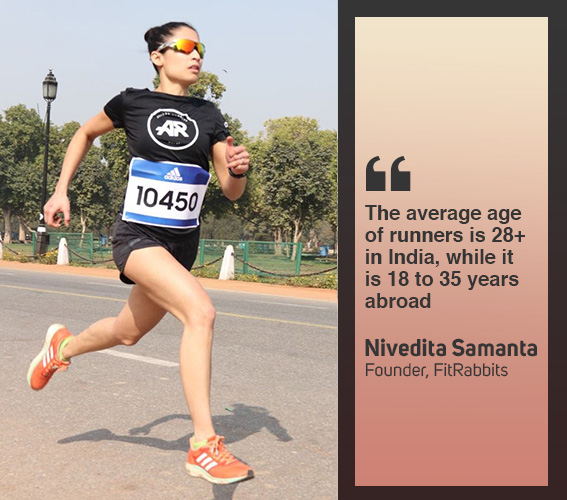
She fancies the German sportswear leader’s running shoes, shorts and sports bras. She feels it has made efforts to stock the right products. For instance, the shorts are longer for women and there is a variety of tights available; the sports bras are up to C and D cup size; T-shirts are of loose fit. She adds, “I enjoy the breathability and the lightness quotient in their shoes with a wider toe box.”
Lasting growth
Wazir Advisors in its “Textile & Apparel Industry Report” argues that manufacturing competitiveness will be the key to tap the trade gap created by China by 2025. Globally artificial fibres will continue gaining market share. If India wants to further drive trade and investments in this sector, it will have to better its preferential market access, the report adds.
Also read: Nascent social entrepreneurship sector in India is beginning to look at women leaders for growth




